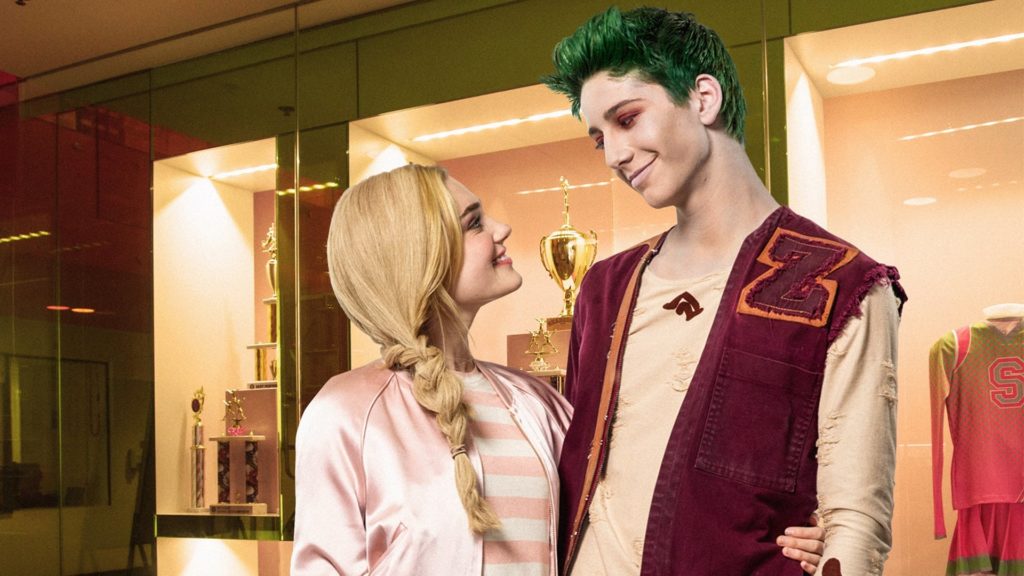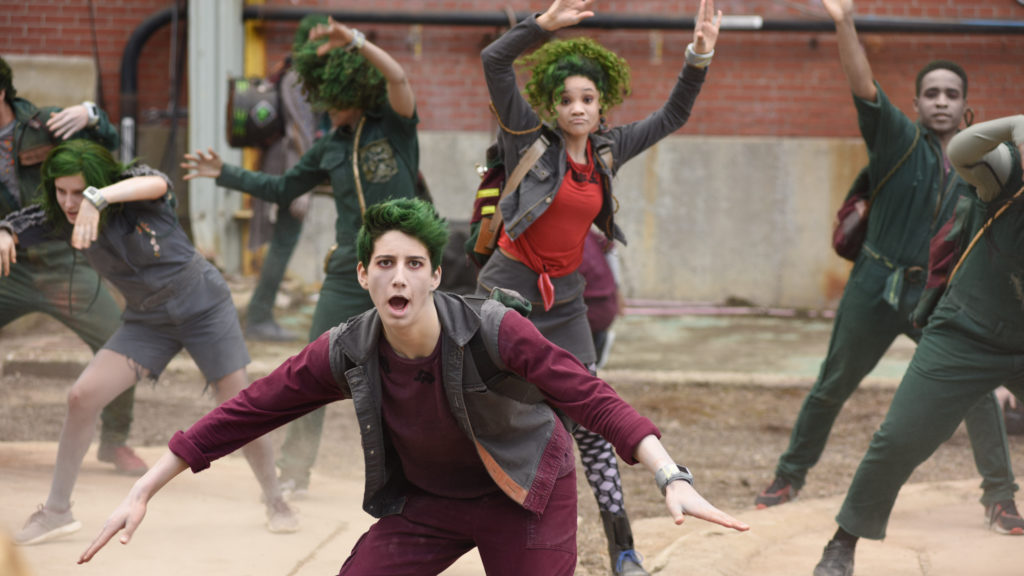"What could go so wrong with a girl and a zombie?"
In the two years since I first saw it, Z-O-M-B-I-E-S has become one of my favorite films to ponder and discuss and push upon unsuspecting viewers. That’s not the same as it being my favorite movie – good God no – but I find this cultural artifact deeply fascinating, strange, and intriguing, rewarding numerous revisits despite its many, many flaws.
The musical, which debuted on the Disney Channel in 2018, follows the romance between a human cheerleader, Addison (Meg Donnelly), and a zombie football player, Zed (Milo Manheim). In this cartoonish universe, the bloody violence of a zombie outbreak is a hastily dismissed footnote. Zombiism has been curbed with something called a Z-band, which functions like a nicotine patch, offering zombies a low-dose zap of hormones to suppress their brain-lust and transform them into functional members of society. However, zombies still retain their pale skin, green hair, and poverty, making them easy to distinguish from ‘normal’ humans.

As a new school year begins, which is introduced by the buoyant opener “Our Year,” zombie and human high schools are undergoing integration for the first time, much to the dismay of many prejudiced humans. However, Addison, who has a shock of unnaturally platinum blonde hair that her parents force her hide under a wig (a mystery not explained until the third film in the series), has a degree of sympathy for the marginalized zombies.
That’s right: Z-O-M-B-I-E-S is a story about racism and a white savior. At the very surface, it’s a nice “accept others” message. But you don’t need to dig too deep to realize how ungodly misguided and batshit this analogy really is. The zombies are afflicted with an incurable ‘deformity’, their ‘condition’ threatening to turn them into flesh-eating ‘monsters’ if they don’t conform to the culture and lifestyle of the majority group. I don’t think that’s how we want our children to think about minorities.
The whole message is even weirder than it sounds. The entire film is enveloped in a haze of quasi-irony. Much of the script is constructed around the language and mentality of progressive social justice, but it often reads like parody. If I’m being generous to both the filmmakers and the audience, I would interpret Z-O-M-B-I-E-S as a campy pastiche that both sincerely endorses the inclusive content of its message while mocking the self-seriousness of most racism-themed films. But that feels too sophisticated: Occam’s razor would suggest exuberantly catastrophic storytelling.
Decoding the film’s true intent is tough. For instance, Addison’s ballad “Stand” near the climax, where she overcomes her fear of being seen as ‘other’, has the tone and cliché message of your average ‘racism-is-bad’ drama, with a heavy dollop of white saviorism. All irony discarded.
But then they throw out lines like “zombies need to rise up!” and “you’re either pro cheerleader, or pro zombie; what’s it gonna be?” Those are very clearly taking the piss.
So which is it? Goofy parody or sincere misfire? This ambiguity is part of what makes the film so enigmatic; it’s never quite clear how much the film is winking at us. It’s basically exactly what you’d cook up in a lab if you were a boomer inventing a ‘woke’ Gen Z Disney Channel musical. (The third entry even has blue hair and pronoun confusion.) Z-O-M-B-I-E-S simultaneously embraces and mocks its very own existence.

Were it only about its message, Z-O-M-B-I-E-S would be a mere curiosity. Thankfully, it offers much more to the deranged viewer. Directed by Paul Hoen, a Disney Channel original movie veteran who always infuses his projects with a touch of the unhinged, the film has a truly bananas aesthetic, and one I deeply love.
When discussing the look of Z-O-M-B-I-E-S, one must begin with the colors. Frankly, I could dedicate this entire review to discussing its colors alone. They tell a story. This is the greenest and pinkest film you have ever seen. (Maybe not the greenest; maybe not the pinkest — especially once Barbie comes out later this summer — but definitely the greenest AND pinkest.) It’s garish and eye-popping, significantly escalating the heightened reality of Z-O-M-B-I-E-S and making its busted racism parable even more freakadelic. I can’t say the film’s color palette is objectively good. In fact, I might go so far as to call it an aesthetic atrocity. But car crashes are fun to watch, and damn do I enjoy letting Z-O-M-B-I-E-S make my eyeballs bleed. It’s truly something else.

The human world is saturated with lime green and electric pink set against bright white, with accents of powder blue. In contrast, the zombies – who speak a language called ‘Zombie’ and live in a neighborhood called ‘Zombieland’ (too obvious?) – have a color scheme that more closely resembles Jack Nicholson’s Joker: dark green and deep purple. Most of the zombies look like they’re cosplaying at a Batman villain convention, complete with purple clothes, pale white skin, and green hair. (The makeup and hair dying is, alas, all over the place from scene to scene.)
The production design amplifies the film’s surrealism, too. The humans reside in a pristine, angular, inorganic suburban utopia, whereas the zombies are confined to a ghetto that resembles an overgrown city block. It’s fun, but I wish the production design had been even more audacious to match the full-tilt spectacle of the color design. A no-holds-barred Tim Burton-style expressionistic wonderland would’ve been a delight. Z-O-M-B-I-E-S occasionally reaches these heights (during the wacko number “BAMM,” for instance), but not often enough.
Seabrook High School is a topsy-turvy setting that perfectly fits the film’s silliness. Here, cheerleading is the dominant sport, overshadowing football, which is a mere side attraction. In a film with more obvious control of its tone, we’d call this “satire,” but I can’t say here. The football coach (Jonathan Langdon) views the job as a nuisance, and the varsity team are the school’s outcasts. Meanwhile, the ‘king’ on campus is the captain of the cheerleading team, Addison’s cousin Bucky (Trevor Tordjman), who doubles as the villain of the story.
Despite the humans’ rampant anti-zombie bigotry, their student body is a diverse panacea. Students represent a spectrum of skin colors and body sizes. Some characters are gender-ambiguous in presentation, and while there are no explicitly queer characters in the first film, they are introduced in the later films without any fuss. The only intolerance at Seabrook is against the undead. It’s galaxy brain discrimination.

Where was I? Oh, right, waiting a thousand words to get to the most objectively good part of the film: The production and choreography of its musical numbers. On top of everything else, Z-O-M-B-I-E-S is a delightful book musical. My favorites are opener “My Year,” the psychedilic “BAMM,” and especially “Someday,” the midtempo romance number. The latter features a cozy production with cool use of lights and props. I dare you to watch this and not be at least a little charmed:
Alas, even with the consistently compelling staging, the tunes themselves are inconsistent. Most of it is overproduced radio pop. And speaking as someone who loves plenty of overproduced radio pop, nothing here is even very good at being it.
The film’s cast is a mixed bag, but the unequivocal highlight is Manheim as Zed. The lanky zombie has funny line delivery and chemistry with everyone in the ensemble. His long, angular body is fun to watch in his strong choreography, and he brings a lot of spirit to the role. On the flip side, I’ve come lower and lower on Donnelly’s performance as Addison with each viewing — at her best, she’s simply mugging cutely; just as often, she’s not doing much of anything. (Watch the above linked clip of “Someday” and try compare exactly what Manheim and Donnelly are contributing to the scene to see the gap between the pair.)
The supporting cast, meanwhile, keeps up the quasi-camp well enough, though I’ve never been wild about Tordjman. On the one hand, he’s an astonishing physical performer, dancing and flipping around the screen with remarkable dexterity (and no stunt double). But Bucky could really use more menace and haughtiness than Tordjman offers. In another situation, it might be ironic that the villain in a zombie movie is the most boring human character in the movie, but Z-O-M-B-I-E-S exists in post-irony state.

The film’s pacing slows the fun, too: The opening half zips much more briskly than the second. The early half also features almost all of the original numbers. The second half has too many music-free stretches and reprises, plus a relative absence of actual narrative scenario for the characters to engage in; mostly stumbling to the climax and waiting for the resolution. There’s almost no third act in this screenplay. This problem is particularly glaring when the film dedicates several minutes of the climax to a montage of previous scenes in the film in lieu of actual narrative.
Ultimately, though, Z-O-M-B-I-E-S is so unusual and perplexing in ways that I value that it’s tempting for me to overrate it. It is a deeply fascinating piece of made-for-TV cinema that simply drowns you in its quirky personality. It’s broken in numerous ways, but that’s not really what matters: Z-O-M-B-I-E-S makes for good and challenging art in the way it transforms boring cliches into whackadoodle weirdness. Its presentation is unique enough for Z-O-M-B-I-E-S to really register as something special. “Special” is not always synonym for “good,” of course, but I will be brave and foolish enough to say that Z-O-M-B-I-E-S is both.
Is It Good?
Good (5/8)
Dan is the founder and head critic of The Goods. Follow Dan on Letterboxd. Join the Discord for updates and discussion.


7 replies on “Z-O-M-B-I-E-S (2018)”
Okay, this is a stupid question, but why would zombies be poor? Wouldn’t they be as rich as they were when they undied? Like, what, do their estates probate anyway? Or do they get poor because they lose their jobs because now they’re incoherent zombies, is that right?
The anti-undead discrimination and subsequent job loss explains part of the poverty. But, yeah, it’s messy. The outbreak happened just a couple decades ago, yet they are entrenched in zombie ghettoes as if that’s the way it’s always been. There might be a throwaway line about the localization of the zombie breakout, maybe in a “worse part of town”?
There are no stupid worldbuilding questions when it comes to the Z-O-M-B-I-E-S world, much like the Cars world. Or, I guess, every question is equally stupid.
Ooh I think I can answer this one. Yes, the zombies were primarily the people who lived in the urban area near the power plant, so presumably started out as economically disadvantaged
If different was a superpower, this movie’d be flawless
I love you Addison you are the best I have wached zombies 1,2,and 3 they where all good I loved them
Glad to hear you’re a fan, Kenna! They are really fun movies. I just re-watched all three with my family in the past month or two 🙂